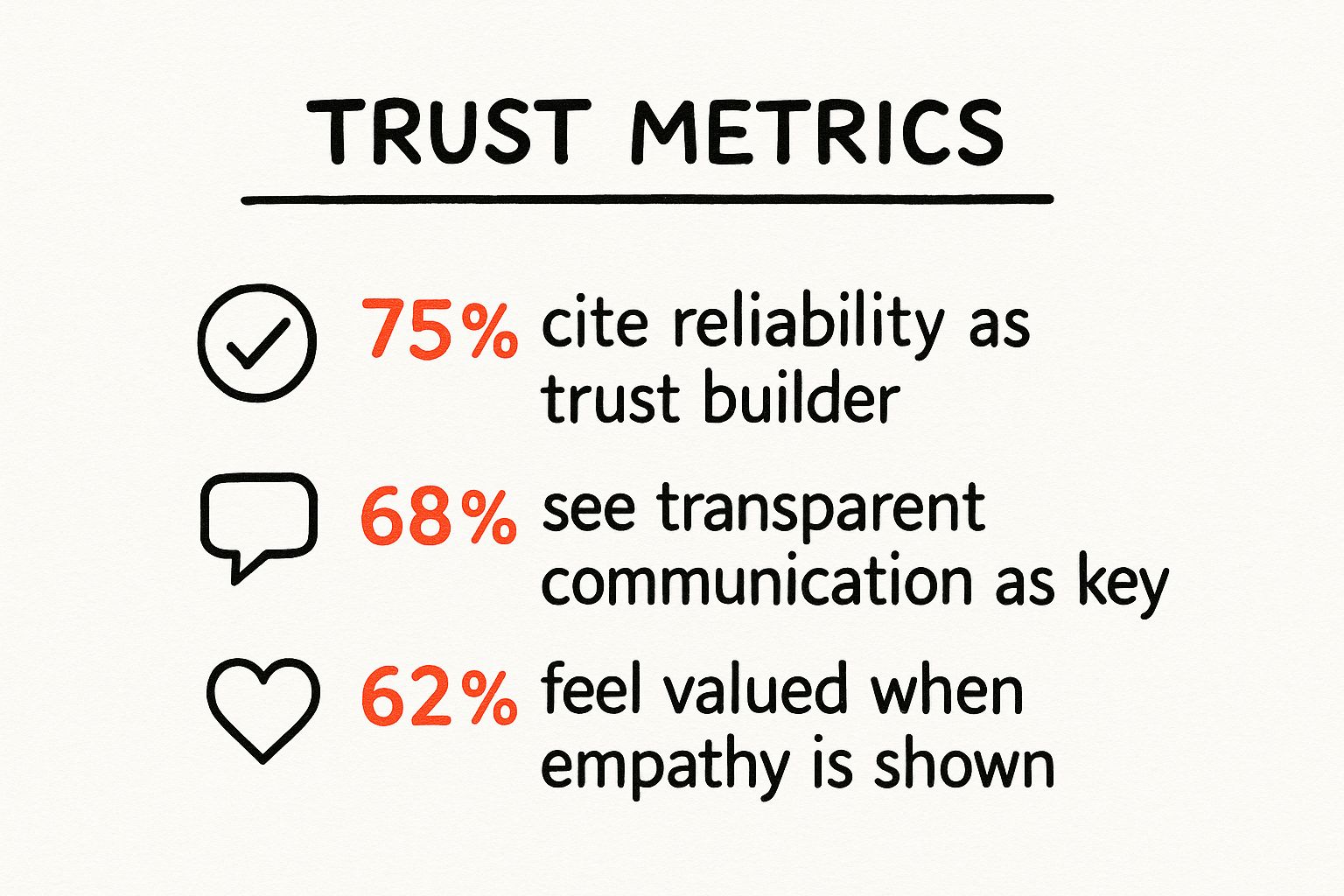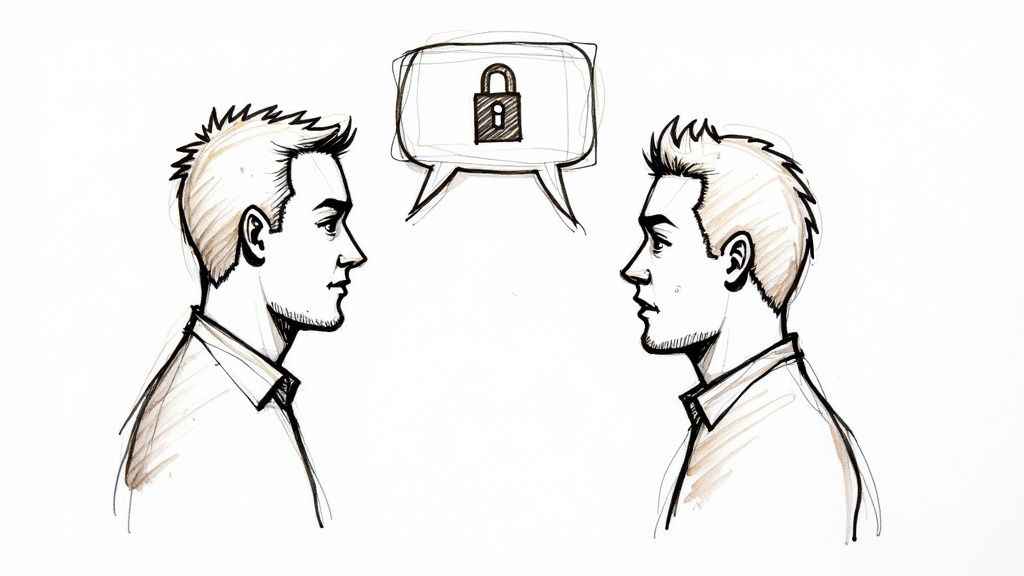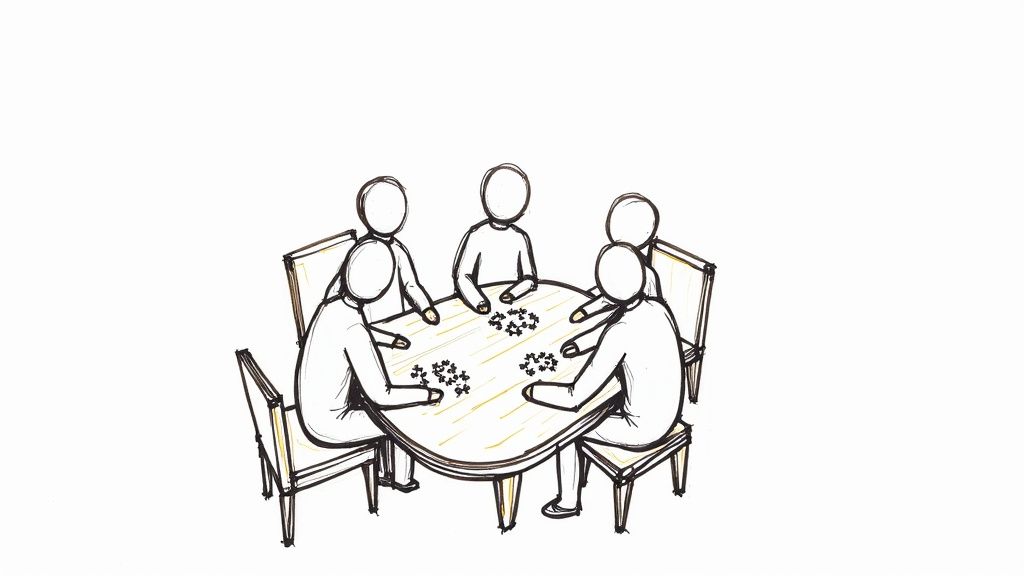How to Build Trust in Teams A Leader's Practical Guide

When you're trying to build trust within a team, it all comes down to a few core fundamentals: creating psychological safety, keeping communication lines open and honest, and getting everyone aligned with a shared purpose. By focusing on these pillars, you can turn trust from a fuzzy concept into something you can actually measure—a real driver of performance and resilience.
Why Trust Is Your Team's Most Valuable Asset
Let’s be clear: trust isn't just a "nice-to-have." It’s the single most critical asset that separates struggling teams from high-achieving ones. It's the very foundation of psychological safety, which in turn fuels innovation and builds resilience. When your people feel safe, connected, and supported, they don't just show up—they engage deeply, collaborate openly, and commit fully to the team's success.
This guide is all about the how. We're moving past the feel-good platitudes to give you actionable frameworks for building genuine trust. The business case is impossible to ignore. A high-trust environment is directly linked to better employee satisfaction, higher retention rates, and stronger financial performance. It's the invisible glue holding your best teams together.
The Real Building Blocks of Trust
So, what does building trust look like day-to-day? It boils down to three behaviors leaders have to live and breathe: reliability, transparency, and empathy.
This image highlights what employees consistently say are the most important factors for them.

The data is pretty revealing. While things like communication and empathy are crucial, for most people, trust starts with reliability—simply following through on your commitments.
Trust is the willingness to be vulnerable to another person's actions. In a team setting, this means feeling confident that your colleagues have your back, will deliver on their commitments, and will treat your ideas with respect.
When that confidence is missing, psychological safety crumbles. People start holding back. They won't share that wild idea, admit a mistake, or challenge a flawed plan. That hesitation is a direct threat to innovation and problem-solving. A low-trust environment isn’t just a morale problem; it’s a performance killer.
Weaving Trust Through Collaboration
A huge part of building trust is simply creating opportunities for people to connect and work together effectively. It sounds simple, but the impact is profound. According to a report by Buffer, nearly 75% of employees view teamwork and collaboration as vital to their jobs.
Even more telling, research from Gallup has shown that employee satisfaction can jump by as much as 50% when people work alongside colleagues they consider friends. The same research revealed that for women, having a best friend at work can actually double their engagement levels.
To really capitalize on this, you need to implement effective team collaboration strategies that do more than just assign tasks—they need to foster a sense of shared ownership and success.
To help you focus on the key areas, here’s a quick breakdown of what these core pillars of trust look like in practice.
The Three Pillars of Team Trust
| Pillar | What It Looks Like | Why It Matters |
|---|---|---|
| Reliability | Team members consistently meet deadlines, keep promises, and produce high-quality work. Leaders follow through on commitments. | Creates a predictable and stable environment where people can count on each other. It’s the bedrock of professional respect. |
| Transparency | Information is shared openly and honestly. Decisions are explained, and feedback (both good and bad) is delivered constructively. | Prevents rumors and misinformation. When people understand the "why" behind decisions, they feel respected and included. |
| Empathy | Colleagues show genuine care for one another. Leaders actively listen, try to understand different perspectives, and support well-being. | Builds strong interpersonal bonds and psychological safety. It makes people feel seen and valued as human beings, not just workers. |
Ultimately, building a high-trust culture isn't a one-time initiative; it's an ongoing process of aligning what you say with what you do.
You can't manage what you don't measure. If you want to get a real pulse on where your organization currently stands, a great first step is to learn how to run a proper culture survey. Our guide at https://www.myculture.ai/blog/culture-survey-guide-measure-transform-workplace-culture walks you through the entire process, from design to action plan. It's the perfect starting point for your journey toward a higher-trust workplace.
Creating Psychological Safety in Your Team

If you're aiming to build a high-trust team, psychological safety is the road you take to get there. It's the unspoken agreement that it's okay to be human at work—to ask for help, question a decision, or even admit you dropped the ball, all without fearing punishment or humiliation. As a leader, you are the chief architect of this environment.
Now, this isn't about being overly "nice" or dodging tough conversations. Quite the opposite. Psychological safety is what makes those difficult, crucial conversations productive. When your team feels genuinely safe, they're willing to challenge the status quo, which is the very engine of innovation. The link is undeniable: without safety, you won't get the candid dialogue required to build real, lasting trust.
You can feel the difference. In a low-safety zone, meetings are dead silent, problems fester under the surface until they explode, and blame is the default response. But in a high-safety environment, there’s a buzz. You'll hear healthy debate, laughter, and a collective drive to solve tough problems because everyone knows the team has their back.
Model Vulnerability First
The single most effective way to foster psychological safety is to show it yourself. When you, as the leader, openly say, "I don't have the answer here," or share a past failure and what you learned from it, you send a powerful message. It tells your team that perfection isn't the goal—learning and authenticity are.
This isn't about dramatic confessions; it’s about being real.
- Admit when you're wrong: A simple, "You know what, my approach was off. Your idea is stronger. Let's run with that," can build more trust than a dozen off-site team-building days.
- Share your thought process: Instead of just announcing a final decision, walk the team through your reasoning, including your uncertainties. Try something like, "Here's what I'm thinking, but I'm worried about X. What am I not seeing?"
- Ask for help: Directly asking for your team's expertise demonstrates respect for their skills and shifts the dynamic from a rigid hierarchy to a genuine partnership.
This behavior normalizes vulnerability for everyone. It’s the essential first move in building a team where trust isn't just a poster on the wall, but a lived reality.
Establish Clear Rules for Engagement
Psychological safety isn't a free-for-all; it actually thrives within a clear structure of mutual respect. You need to work with your team to set explicit ground rules for how you'll interact, especially when things get heated.
In its famous Project Aristotle study, Google's researchers found that psychological safety was by far the most important of the five key dynamics of effective teams. It was the underpinning of the other four: dependability, structure & clarity, meaning, and impact.
This shouldn't be a top-down mandate. Co-create these "rules of engagement" with your team so everyone feels ownership. Your list might include principles like:
- Challenge ideas, not people.
- Assume positive intent.
- Listen to understand, not just to respond.
- During brainstorming, no idea is a bad idea.
Once you've agreed on these rules, your job is to be their guardian. Gently redirect conversations that go off-track and publicly praise people who exemplify these behaviors.
Actively Solicit and Reward Input
On any team, some people are naturally more talkative than others. Real psychological safety has to include everyone, not just the loudest voices. This means you need to be deliberate about creating opportunities for quieter team members to share their thoughts.
You can do this by directly inviting them into the conversation: "Sarah, you have a lot of experience here. I'd love to get your take on this." This shows you value their specific expertise. You can also use methods that don't put people on the spot, like sharing ideas in a shared doc before a meeting or using anonymous polls. Getting good at this means asking the right questions; reviewing a list of well-crafted employee engagement survey questions can give you great ideas for encouraging more thoughtful feedback.
Finally, when someone does take a risk—by voicing a half-formed idea, pointing out a flaw in your plan, or admitting a mistake—how you react is everything. Thank them for their honesty. Acknowledge their courage. This positive reinforcement shows the entire team that speaking up isn't just safe; it's valued.
Building Trust Through Consistent Communication

If psychological safety is the soil where trust can take root, then consistent communication is the water and sunlight that makes it grow. This isn't about flooding inboxes or packing calendars with more meetings. The real key to building trust is communicating with intention and reliability.
Think of every single interaction as a deposit or a withdrawal from a shared trust account. When your communication is predictable, open, and empathetic, it stops being a simple exchange of information. It becomes the very engine that drives your team forward with confidence, especially when the path ahead is unclear.
Let's move past the theory and get into the practical, daily habits that actually build trust from the ground up.
Mastering the Say-Do Ratio
The single most critical element of trustworthy communication is reliability. In my experience, this boils down to one simple concept: the 'say-do ratio'. It means your actions have to consistently line up with your words.
When you make a promise, you keep it. When you set a deadline, you meet it. When you talk about company values, you live them. It's that straightforward.
This consistency is the absolute bedrock of professional trust. People trust what they can predict. If your team knows you're dependable, they can pour their energy into great work instead of worrying if you'll follow through.
A 2024 PwC survey uncovered a major "trust gap" in the workplace. While 86% of business executives believe their employees trust them highly, only 60% of employees say they highly trust their company. That gap is often a direct result of inconsistent leadership communication and a poor say-do ratio.
Improving your say-do ratio starts with being more deliberate about your commitments. Before you make a promise, take a beat. Can you realistically deliver? It's always, always better to under-promise and over-deliver.
Practicing Radical Transparency
Transparency is so much more than just telling the truth. It's about proactively sharing information, giving context, and explaining the "why" behind decisions. This is never more important than during times of change or uncertainty, when silence can breed fear and misinformation.
Here’s what effective transparency looks like in action:
- Sharing the 'Why': Don’t just announce a change; walk the team through the factors that led to the decision. When people understand the context, they’re far more likely to get on board, even if they don’t love the outcome.
- Admitting What You Don't Know: It’s incredibly powerful to say, "Here's what we know for sure, here's what we think might happen, and here are the things we just don't have answers for yet." That kind of honesty builds credibility faster than pretending you have a crystal ball.
- Creating Predictable Information Flows: Set up a regular rhythm for important updates. Maybe it's a weekly project summary or a monthly all-hands focused on business performance. This predictability lowers anxiety because your team knows exactly when and where to expect key information.
To really get this right, you might want to dive deeper into some internal communication best practices to sharpen your strategy.
The Power of Active Listening
The final piece of the puzzle is proving you actually hear your team, not just waiting for your turn to speak. Active listening is a skill, and it’s one that signals deep respect and empathy, making people feel seen and valued.
It means putting your phone away during conversations, making eye contact (yes, even on video calls!), and asking questions that show you're engaged. You're listening to understand, not just to craft a reply.
Try these simple techniques in your next conversation:
- Paraphrase and Summarize: After someone shares an idea, try saying, "So, if I'm hearing you correctly, you're suggesting we..." This confirms you were paying attention and gets everyone on the same page.
- Ask Open-Ended Questions: Ditch the "yes" or "no" questions. Instead, ask things that encourage real thought, like, "Can you walk me through your thinking on that?" or "What challenges do you see with this approach?"
- Acknowledge the Emotion: Sometimes the most important part of a message isn't the words, but the feeling behind them. Recognizing it with a simple phrase like, "It sounds like you're feeling frustrated by this deadline," shows empathy and forges a much stronger connection.
By weaving reliability, transparency, and active listening into your daily interactions, you turn communication from a routine task into your most powerful tool for building and sustaining team trust.
Uniting Your Team Around a Shared Purpose
A team that knows why they're doing what they're doing is unstoppable. When people can draw a straight line from their daily tasks to a larger mission, a switch flips. They stop being just a group of individuals and become a cohesive force, all pulling in the same direction. This sense of shared purpose isn't just a nice-to-have; it's the bedrock of real team trust.
As a leader, one of your biggest responsibilities is to not just define that mission, but to constantly bring it to life. It’s about connecting the dots between someone's Monday morning to-do list and the big-picture goal. This is what separates assigning work from inspiring a movement. Trust grows organically when people feel they're part of something important, something bigger than themselves.
From Assigned Groups to Truly Interdependent Teams
Real teamwork isn't just about sharing a project folder. It's about designing work so that one person's success genuinely depends on another's. This shifts the mindset from "my part is done" to "we win or lose together."
When a team truly succeeds or fails as one, they build a powerful bond forged in the trenches. This is where you see deep, resilient trust take root.
So, how do you make this happen? Structure projects that demand a mix of skills. Instead of having three software engineers work on three separate features, give them one complex feature that requires all of them. Maybe one handles the backend logic, another builds the front-end interface, and the third manages the database integration. They simply can't succeed unless every single person delivers.
Exercises That Build Collaborative Muscle
Forget the awkward icebreakers. The best team exercises are the ones that feel like a dress rehearsal for real-world challenges, forcing the team to solve problems together. These aren't just for fun; they're designed to sharpen communication, hone problem-solving, and reinforce that feeling of mutual reliance in a low-stakes setting.
Here are a couple of my favorites:
- The Silent Build: Grab a complex LEGO set, but with one rule: no talking. Team members have to rely entirely on non-verbal cues, a shared reading of the instructions, and anticipating each other's moves. It’s a brilliant way to show how much we lean on clear communication—and how to adapt when it's gone.
- The Hypothetical Crisis: Throw a realistic business problem at them. "Our main competitor just launched a feature that makes ours obsolete. We have one week to pitch a counter-strategy to the board. Go." This forces the team to brainstorm, debate, and align on a plan under pressure, building trust in their collective decision-making.
These kinds of activities do more than just fill an afternoon; they build the "collaborative muscle" your team needs for when the stakes are real. In fact, many effective community building strategies can be adapted to strengthen internal team bonds by focusing on that same sense of connection and shared values.
Trust is the natural outcome of a team that has faced a challenge together and come out the other side. That shared story of 'we did it' is far more powerful than any top-down mandate to 'trust each other.'
It’s the journey—the struggle, the breakthrough, and the shared win—that cements their bond.
The Measurable Impact of a United Team
Here’s the thing: investing in a shared purpose isn't just about good vibes. It pays off in real, measurable ways. The data is clear—building trust through teamwork has a direct impact on the bottom line. Research from Zippia indicates that team cohesion can lead to a 25% increase in team performance, driven by better efficiency and alignment.
It also has a massive effect on retention. The same report found that businesses that regularly invest in team-building activities report a 36% higher retention rate. It turns out that trust is a key ingredient in employee loyalty. To see more data on this, explore the findings on team-building's ROI.
Ultimately, a team united by purpose creates a powerful, self-reinforcing cycle. A clear mission drives collaboration, and that collaboration builds trust. This trust creates a psychologically safe environment where people are more engaged, and that engagement fuels the team's ability to hit its goals. To go deeper on this, our guide to creating a culture of engagement offers more strategies to keep this cycle going.
How to Measure and Maintain Team Trust

Here’s something I’ve learned over the years: building trust isn't a project you can just check off a list. It’s a living, breathing part of your team's culture. Think of it less like a building and more like a garden—it needs constant attention and care, or it will simply wither away.
That means you have to get good at measuring it. You need tangible ways to see what's really going on so you can spot the small issues before they become full-blown crises. It's all about proactive maintenance. Instead of just reacting when things go wrong, you're constantly taking the team's temperature. This allows you to double down on what’s working and fix the small fractures before they crack the team’s foundation.
Quantitative Ways to Track Trust
While trust feels like an abstract concept, you can absolutely track its key ingredients with data. Using quantitative tools gives you hard numbers to monitor progress and pinpoint exactly where you need to focus your energy.
Anonymous surveys are probably the most powerful tool you have here. When people know they can share their real thoughts without any blowback, you get the kind of unfiltered, honest feedback that’s pure gold.
- Pulse Surveys: These are short, frequent check-ins, maybe weekly or bi-weekly. They let you track sentiment on specific, trust-related questions like, "I feel safe speaking up with ideas and concerns on my team."
- Deeper Dives: On a quarterly or semi-annual basis, you can go a bit deeper. These surveys can dig into the core pillars of trust—things like perceptions of fairness, leadership reliability, and psychological safety.
Platforms like MyCulture.ai can handle the entire survey process for you, serving up data-driven insights that reveal trends across different teams or the whole organization. You can get a better sense of this approach in our guide to measuring employee engagement.
This screenshot gives you a glimpse of how a platform can turn that raw data into a clear visual story, helping you spot strengths and weaknesses in seconds.

With a dashboard like this, you’re no longer guessing. You're using real evidence to shape your trust-building strategy.
Reading the Qualitative Cues
Of course, numbers only tell half the story. You also have to become a keen observer of the day-to-day behaviors that signal the true health of your team's trust levels. These qualitative observations give you the "why" behind the data.
I always recommend building 'trust check-ins' into your regular one-on-ones. Go beyond the typical task and deadline updates. Carve out space to ask open-ended questions like, "How are you feeling about how the team is collaborating right now?" or "Is there anything blocking you that you haven't felt comfortable raising with the group?"
A broad analysis by Gallup shows that trust isn't just a feel-good metric; it directly impacts the bottom line. Highly engaged teams, a direct outcome of trust, can result in a 14% increase in productivity, an 18% increase in sales, and a 23% boost in profitability.
Keep a close eye on your meeting dynamics. Are people actively challenging and building on ideas, or is there just compliant silence? Healthy, respectful debate is a huge sign of trust; a lack of it often points to fear. Also, watch for friction between departments. If you start hearing a lot of finger-pointing or see teams hoarding information, it’s a massive red flag that trust has broken down.
Strategies for Repair and Reinforcement
When you spot a dip in trust—and you will—you need to act fast. Fixing broken trust always starts with calling it out directly and taking ownership of any leadership missteps that contributed to it.
First, acknowledge the problem and apologize. If a recent decision broke trust, get in front of the team and address it head-on. A sincere apology and a clear explanation of what you'll do differently is the only way to begin.
Next, co-create the solution. Don't just dictate the path forward. Involve the team in figuring out how to move on. This gives everyone a sense of ownership and helps them reinvest in the team's collective success.
Finally, make a point to reinforce positive behavior. When you see someone being vulnerable, supporting a colleague, or taking accountability for a mistake, call it out. Recognizing these moments publicly reinforces the exact culture you're trying to build. You’re showing everyone what a high-trust environment actually looks like in practice.
Your Burning Questions About Team Trust
When it comes to building trust, the theory is one thing, but the reality of leading a team brings up a whole different set of challenges. We all grapple with similar questions on the ground. Let's tackle some of the most common ones I hear from leaders, moving beyond the textbook answers to what actually works.
How Quickly Can You Build Trust in a New Team?
You can't manufacture deep trust overnight—that's a marathon, not a sprint. But you can absolutely lay a solid foundation within the first 30 to 90 days. It all comes down to scoring some quick wins that prove you're reliable.
Think about it: a new team is watching your every move. They're sizing you up, paying incredibly close attention to your ‘say-do ratio’—the gap between what you promise and what you actually deliver. To get that initial trust locked in fast, you have to be intentional.
- Be the first to be vulnerable. In your first few meetings, admit you don't have all the answers. Ask for their expertise. This isn't weakness; it’s a powerful signal that you value collaboration over ego.
- Set the ground rules together. Don't let communication norms just happen. Work with the team to define how you'll give feedback, what response times are fair, and how you’ll run meetings. Predictability creates psychological safety.
- Sweat the small stuff. If you promise to send meeting notes, send them. If you say you'll follow up on a question, do it without fail. These small, consistent actions are the currency you use to buy initial trust.
This early professional trust—the feeling that you're competent and reliable—can be earned in a couple of months. The deeper, more resilient trust that helps a team navigate real conflict and crisis? That takes longer, often six months or more, as you weather storms and celebrate wins together.
What Is the Fastest Way to Destroy Team Trust?
Hands down, the single fastest way to poison a team’s trust is hypocrisy. Nothing craters morale faster than a leader who says one thing and does another. We're not talking about an honest mistake; we're talking about a fundamental breach of integrity.
When your actions don't match your words, you send a clear message: the rules don't matter, and our stated values are just for show. People immediately become cynical and guarded. They stop believing anything you say and disengage to protect themselves.
It's a bigger problem than most leaders realize. PwC's 2024 Trust in US Business Survey revealed that while 86% of business executives believe they highly trust their employees, a mere 60% of employees actually feel that high level of trust in return. That gap is often fueled by leaders who aren't walking the talk.
Here's what this looks like in the real world:
- Preaching the importance of open feedback, but then subtly sidelining the person who dared to offer a critique.
- Hinting at a promotion or exciting new project, only to let it fizzle out with no explanation.
- Championing work-life balance in a team meeting, then firing off emails at 10 PM and expecting a response.
The antidote is rigorous self-honesty. Follow through on your commitments. And when things change—because they always do—be radically transparent about why. Explaining the reasoning shows respect and preserves your credibility, even when the news is bad.
Can Trust Be Rebuilt After It Has Been Broken?
Yes, but don't underestimate the work involved. Rebuilding trust is a slow, humbling, and painful process. It demands unwavering consistency from the person who broke it, and there are absolutely no shortcuts.
The journey back has to start with genuine accountability. From my experience, it requires a few non-negotiable steps:
- A Real Apology. Not a "sorry if you felt that way" non-apology. It must be a direct, specific acknowledgment of the action and—most importantly—the impact it had on others. No excuses.
- A Long Period of Changed Behavior. Words are cheap. The person must demonstrate, day in and day out, that they are committed to being reliable and transparent. This observation period can take months, as the team waits to see if the change is real.
- An Open Door for Dialogue. The team will need a safe space to process and ask hard questions as they learn to trust again. A good leader facilitates this, ensuring it doesn't devolve into a blame game.
The relationship might never be exactly the same, but you can absolutely get back to a strong, functional level of professional trust. It just takes a shared commitment to move forward and a belief that people can learn from their mistakes.
How Do You Build Trust in a Fully Remote Team?
With a remote or hybrid team, you have to be far more intentional. You lose all those spontaneous, trust-building moments that happen in an office—the chat by the coffee maker, the walk back from a meeting. Every single touchpoint has to be created on purpose.
Because you lack the nuance of in-person body language, you have to over-communicate with absolute clarity. This means spelling out everything: expectations for availability, project goals, and which channel to use for what kind of communication.
Here are a few strategies that make a real difference:
- Default to "Cameras On." Seeing facial expressions and reactions is crucial for building human connection. Encourage video during team calls to bring back some of that lost non-verbal data.
- Schedule Time for Nothing. Carve out dedicated time for non-work chatter. A virtual coffee break, a team lunch over Zoom, or a quick online game—these moments of pure connection are vital.
- Make Recognition Public. In a remote world, it’s easy for great work to go unnoticed. Make a habit of celebrating wins, big and small, in a public channel like Slack or in a team-wide email. It ensures people feel seen.
- Create Clear Boundaries. Prevent burnout by establishing firm norms around response times and working hours. This isn't just a wellness policy; it's a powerful signal of respect for people's lives outside of work.
Ultimately, building trust with a remote team comes down to proving you care about them as people, not just as avatars on a screen.
Ready to move from guessing to knowing? MyCulture.ai provides the data-driven insights you need to build, measure, and sustain a high-trust culture. Our science-backed assessments help you understand team dynamics, identify trust gaps, and make informed decisions to foster collaboration and engagement. Start building a stronger, more cohesive team today. Learn more about how MyCulture.ai can help.